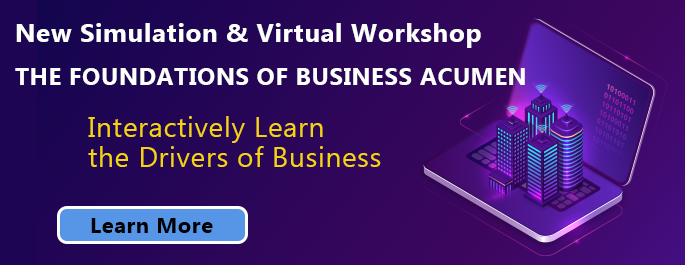One of the hardest skills to develop in 2021 and beyond will be Business Acumen. In the new workplace where employees are working extremely hard in the hybrid work environment and the integration of work, life, and learning will become even more volatile, complex skills like Business Acumen will need new approaches in order to be addressed and learned.
where employees are working extremely hard in the hybrid work environment and the integration of work, life, and learning will become even more volatile, complex skills like Business Acumen will need new approaches in order to be addressed and learned.
One of the most effective ways of building Business Acumen skills is through business simulation-centric learning where participants learn-by-doing. A digital, cloud-based simulation is a case study that comes to life and presents learners with a chance to set a strategy, execute that strategy through operational decisions, and then measure success by reviewing financial reports.
Advantexe recently deployed a 4-hour virtual learning program for a manufacturing client that leveraged synchronous and asynchronous components including pre-work and a business simulation called Zodiak Pro®. Zodiak Pro was developed in collaboration with Paradigm Learning and takes a best-selling board game simulation to a new digital level
Over the course of 3 simulated years, learners set a strategy and made day-to-day operational business decisions in marketing, sales, R&D and more to help Zodiak Incorporated generate more revenue, manage cash flow, turn a profit, grow shareholder value, and lead the company into the future. At the end of the session, teams participated in “Board of Director” presentations where they presented their business strategy, defended their results, and discussed the challenges and opportunities they faced while running the simulated company.
About 100 participants engaged with the simulation and the results were outstanding. Below is an overview of the key Business Acumen metrics measured and how participants rive the success:
Organic Revenue was up more than 6% – Organic revenue is growth of existing products in the portfolio free of acquisition of further major investments in R&D. In the simulation, participants learned how to raise prices incrementally and maintain the highest levels of quality to grow the existing business.
Revenue from New Products (52% growth rate) – Revenue from new products provided much needed help as some of the older products lost their growth and revenue trajectories. In the simulation, new product revenues were not only able to replace the revenue lost from the older products, but they also surpassed the projected total revenue. The increased revenues generated and operating profit that was reinvested back into the business.
Gross Profit was up by over 14.4% - Gross Profit, the difference between revenue and the cost of goods sold, was up dramatically because participants quickly learned that there are only two main ways of growing it; either increasing prices or decreasing the cost of goods sold (COGS)
Net Income (Profit) was up about 5.6% - Participants were able to identify the drivers of profit quickly and realized by raising prices and maintaining or cutting the cost of goods and the investments in Operating expenses such as Sales, Marketing, R&D, Finance, HR, and many more.
Customer Satisfaction (CSAT)was up about 7.3% - Participants learned that if you deliver a quality product at reasonable prices, you were hitting the CSAT mark. It was interesting to note that in the first couple of years, CSAT was down as they had to calibrate the meaning of quality. They realized that quality is actually the “perception of quality” which is driven by R&D investments, Marketing, Service, and how Green the products are.
Total Shareholder Return (TSR) was up about 14% - Total Shareholder Returns includes dividends as well as the appreciation of the value of the stock. In the simulation, participants were able to unlock the secrets of TSR by increasing revenues, increasing profits, and most importantly increasing free cash flow. They were able to understand that driving TSR is difficult because of the challenges related to today when comparing them to the future of the business.
In summary, every participant learned how to improve business performance through simulation-centric learning; especially those with little to no Business Acumen going into the simulation workshop. The best part of the experience was the individual action planning that each participant created to take concepts learned in the simulation and apply them back to their real-world jobs.




